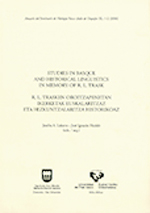One-Place and Two-Place Predicates that Concern the Unaccusative Hypothesis and the Typological Classification of Languages
##plugins.themes.bootstrap3.article.main##
##plugins.themes.bootstrap3.article.sidebar##
Publicado
11-04-2006
Asier Alcázar
Resumen
My research explores the predicate-argument structure of unergatives (cough, dream, float, run, work…) and questions their ontological status as a primitive type of intransitive verb (contra the Unaccusative Hypothesis: Perlmutter 1978; Burzio 1986) or transitive verb (contra Hale and Keyser 2003). For instance, unergatives are transitive in the Basque language, as object agreement and light verb constructions show, among other morphosyntactic evidence. The predictions arising from an ontological commitment are falsifiable in view of the typological classification of languages. If we consider unergatives intransitive, we eliminate split-intransitive languages like Basque. On the other hand, considering unergatives transitive eliminates accusative and ergative languages like English or Dyrbal, where unergatives behave as intransitive verbs. Hence, unergatives are transitive or intransitive on a language particular basis. This prevents an ontological commitment but permits a more articulate classification of languages. The accusative and ergative types derive from languages where unergatives are intransitive. When unergatives are transitive, a split-intransitive type like Basque may emerge. A split-intransitive language with transitive unergatives marks transitivity by discriminating the object of transitives (accusative) or subject of transitives (ergative). Unergatives find a parallel case in reflexives, expressed transitively or intransitively across languages and even inside the same language (Basque, Italian).
Cómo citar
Alcázar, Asier. 2006. «One-Place and Two-Place Predicates That Concern the Unaccusative Hypothesis and the Typological Classification of Languages». Anuario Del Seminario De Filología Vasca "Julio De Urquijo" 40 (1-2):1-22. https://doi.org/10.1387/asju.4366.
##plugins.themes.bootstrap3.article.details##
Número
Sección
Artículos
Esta obra está bajo una licencia Creative Commons Atribución-NoComercial-SinDerivadas 4.0 Internacional.


